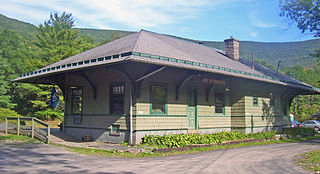
Phoenicia station is a repurposed train station located on High Street just south of Phoenicia, New York, United States. It is a frame building that opened in 1899.

Lake Hopatcong is a commuter railroad station for New Jersey Transit. The station, located in the community of Landing in Roxbury Township, Morris County, New Jersey, United States, serves trains for the Montclair-Boonton Line and Morristown Line at peak hours and on holiday weekends. Service from Lake Hopatcong is provided to/from Hackettstown to New York Penn Station and Hoboken Terminal. The stop is located on the tracks below Landing Road next to the eponymous Lake Hopatcong. The station consists of one active platform with shelter, and an abandoned side platform. There is no accessibility for handicapped people.

Lyons is a New Jersey Transit station in Basking Ridge, New Jersey along the Gladstone Branch of the Morris & Essex Lines. The station serves south Basking Ridge as well as the Hills and Liberty Corner.

St. James is a station and historic landmark on the Port Jefferson Branch of the Long Island Rail Road. The station is located on Lake Avenue and Railroad Avenue, just south of New York State Route 25A in St. James, Suffolk County, New York.
Downsville is a hamlet, census-designated place (CDP), and former village in the town of Colchester, Delaware County, New York, United States. The population was 617 at the 2010 census.

Swampscott station is a historic railroad station in Swampscott, Massachusetts. Located in the southwest portion of Swampscott near the Lynn border, it serves the MBTA Commuter Rail Newburyport/Rockport Line. The historic Stick/Eastlake-style depot building, was originally built in 1868 for the Eastern Railroad, but is no longer in use. The location still serves as an accessible MBTA Commuter Rail stop and park-and-ride location for Swampscott and adjoining Marblehead. The building was added to the National Register of Historic Places in 1998 as Swampscott Railroad Depot.

Southern Pacific Railroad Depot in Whittier, California is a train depot built in 1892 that is being preserved by the City of Whittier to house a railroad museum and community center. The depot is a rectangular two-story, wood-frame building. The station agent lived in the second floor apartment.

North Conway station is a railway station located in North Conway, New Hampshire. Built in 1874, the depot was designed by Nathaniel J. Bradlee in an eclectic Russian-Victorian style. The station is also the terminus for the Conway Scenic Railroad. Northwest of the station stands a roundhouse, which now houses the Scenic Railroad's rolling stock; it was built around the same time as the station. The yard and depot were added to the National Register of Historic Places in 1979 as North Conway Depot and Railroad Yard.

The Frisco Depot and adjacent Antlers Spring are historic sites in Antlers, Oklahoma, United States. The sites are a part of the National Register of Historic Places, in which they appear as a single entry.

Ulster and Delaware Railroad Depot and Mill Complex is a historic railroad depot and national historic district located at Roxbury in Delaware County, New York. The district contains five contributing buildings and one contributing structure. It was developed between about 1876 and 1946 and includes the Ulster and Delaware Railroad Depot, Robinson and Preston Steam Flour and Feed Mill, Slawson-Decker-Sheffield Co Creamery, Ulster and Delaware Railroad Ice House, and George M. Orr Blacksmith Shop.

The Burlington, Cedar Rapids and Northern Railway (BCR&N) was a railroad that operated in the United States from 1876 to 1903. It was formed to take over the operations of the bankrupt Burlington, Cedar Rapids and Minnesota Railway, which was, in turn, the result of merging several predecessor lines, the construction of which began in 1869. The corporate headquarters were in Cedar Rapids, Iowa, and it had operations in Iowa and in Minnesota. It was succeeded by the Chicago, Rock Island and Pacific Railway.
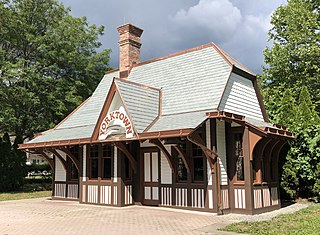
Yorktown Heights station is a former railroad station on the Putnam Line in Yorktown Heights, New York, United States. It is a wooden building located on Commerce Street at the intersection of Underhill Avenue in Railroad Park.
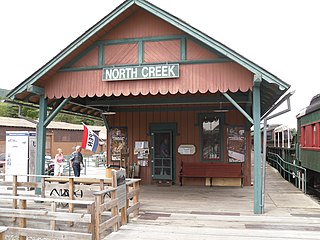
North Creek station is a historic railroad station complex located at North Creek, Warren County, New York. The complex consists of the railroad station, the freight house, round house, turntable, and horse barn. The station was built in 1874 and is a simple, rectangular, gable roofed building with a broad, overhanging strut-supported roof in the Stick-Eastlake style. Its exterior is covered with vertical boards.

The Fargo station is a former railway station in Fargo, North Dakota. Built in 1898, it was listed on the National Register of Historic Places in 1975 as the Northern Pacific Railway Depot.

The Danville Southern Pacific Train Depot in Danville, California is located at 205 Railroad Ave. and W Prospect Ave. It was built in 1891 on land donated by John Hartz which was erected when the Martinez line was extended south to San Ramon. The first train came on June 7, 1891. Passenger service ended in 1934. The Southern Pacific Railroad trains continued to pass through town with freight until 1978 when the line was abandoned. The building was sold in 1951 for the Danville Supply and Feed store. In June 1996, it was purchased and moved 100 yards.

Seaford Station Complex is a historic railway station complex and national historic district located at Seaford, Sussex County, Delaware. It includes two contributing buildings and two contributing structures and considered an outstanding example of a turn-of-the-20th century, unaltered, small-town railroad complex in Delaware. They are the Seaford Railroad Station, Seaford Freight Station, the Nanticoke River moveable railroad bridge, and mainline railroad tracks. The Seaford Railroad Station is brick rectangular building with a large bracketed overhang, built about 1905. The Seaford Freight Station was built about the same time, and consists of an open porch, covered by an arcaded extension of the roof, with an office and store room. The Nanticoke River moveable railroad bridge is an iron through-truss structure carrying a single track. It was built about 1890 by the Pencoyd Bridge and Construction Company of Pencoyd, Pennsylvania. The main line track north of the depot was double-tracked just before World War I.

North Bennington station is a historic railroad station at Depot Street and Buckley Road in North Bennington, Vermont. Built in 1880 as a passenger station, this Second Empire brick building is a surviving reminder of North Bennington's former importance as a major railroad hub in southwestern Vermont. It was listed on the National Register of Historic Places in 1973 as North Bennington Depot.
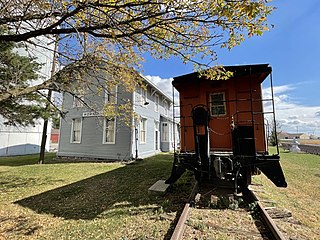
The Chicago, Milwaukee, St. Paul & Pacific Combination Depot-Hornick, also known as the Hornick Depot, is a historic building located in Hornick, Iowa, United States. The town was patted by the Chicago, Milwaukee, St. Paul & Pacific Railroad's land company when the railroad created a branch line from Manilla, Iowa to Sioux City. Completed in 1887, the railroad built this two-story frame structure to serve as its passenger and freight depot. It is one of six such depots that remain in Iowa, and the best preserved. These buildings were built from a standard design used by the railroad. The two-story stations included living quarters for the station manager because the towns had yet to develop when the depot was built. This was an island depot, with freight loaded on the north side and passengers boarded on the south. Decorative elements on this depot include lathe-turned wooden finials, angled wooden brackets, and bracketed door and window hoods. Passenger service ended in the 1950s, and grain was loaded here until 1980 when the Milwaukee Road abandoned the Sioux City branch line. The building was listed on the National Register of Historic Places in 1990. It has been converted into a local history museum.
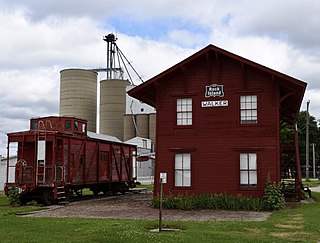
Walker Station is a historic building located in Walker, Iowa, United States. The two-story frame building with bracketed eaves was completed in 1873 along the Burlington, Cedar Rapids, and Minnesota Railway tracks. The depot also served its successor railroads: the Burlington, Cedar Rapids and Northern, and the Chicago, Rock Island and Pacific. Typical of many railroad towns in the Midwest, this is the first building that was built here and the town grew up around it. It is an example of a combination depot that was used for both passenger and freight usage in smaller communities. Because it has a ground level brick platform, service here was primary passenger and light freight service. A higher level of freight service would have required a raised platform.

Gardiner station was a railway station in Gardiner, Montana, serving the Northern Pacific Railway. Gardiner was on the southern terminus of a branch line from Livingston and is at the northern border of Yellowstone National Park. Passengers would be shuttled to/from the park via stagecoach. The station was designed by Robert Reamer in the rustic style. Passenger service eventually diminished from Gardiner, and the station was torn down in 1954.
























